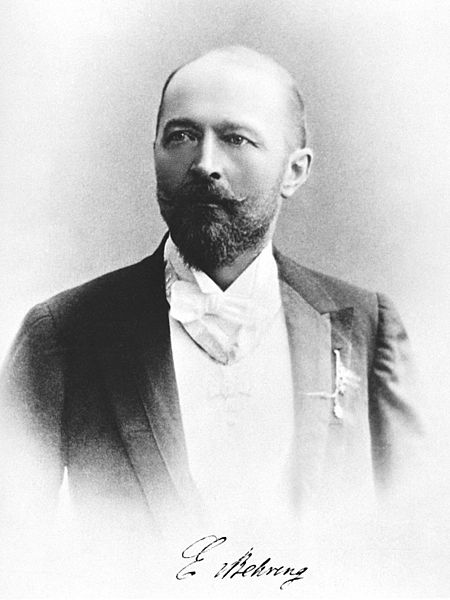<Back to Index>
- Physiologist Emil Adolf von Behring, 1854
- Composer Eduard Strauss, 1835
- Prime Minister of the United Kingdom William Lamb, 2nd Viscount Melbourne, 1779
PAGE SPONSOR

Emil Adolf von Behring (15 March 1854 – 31 March 1917) was a German physiologist who received the 1901 Nobel Prize in Physiology or Medicine, the first one so awarded.
Behring was born Adolf Emil Behring in Hansdorf (now Ławice, Iława County), Kreis Rosenberg, Province of Prussia.
Between 1874 and 1878 he studied medicine at the Akademie für das militärärztliche Bildungswesen, Berlin. He was mainly a military doctor and then became Professor of Hygienics within the Faculty of Medicine at the University of Marburg (against the initial strenuous opposition of the faculty council), a position he would hold for the rest of his life. He and the pharmacologist Hans Horst Meyer had their laboratories in the same building, and Behring stimulated Meyer's interest in the mode of action of tetanus toxin.
Behring was the discoverer of diphtheria antitoxin in 1890 and attained a great reputation by that means and by his contributions to the study of immunity. He won the first Nobel Prize in Physiology or Medicine in 1901 for developing a serum therapy against diphtheria (this was helped by Kitasato Shibasaburo and worked on with Emile Roux) and tetanus. The former had been a scourge of the population, especially children, whereas the other was a leading cause of death in wars, killing the wounded. At the International Tuberculosis Congress in 1905 he announced that he had discovered "a substance proceeding from the virus of tuberculosis." This substance, which he designated "T C", plays the important part in the immunizing action of Professor Behring's "bovivaccine", which prevents bovine tuberculosis. He tried unsuccessfully to obtain a protective and therapeutic agent for humans.
Behring demonstrated that the injection of toxins was able to be transmitted to another animal by injections of a treated animal's blood serum and used as a means of effecting a cure.
Behring died at Marburg, Hessen - Nassau, on 31 March 1917. His name survives in Dade Behring, the world's largest company dedicated solely to clinical diagnostics, in CSL Behring a manufacturer of plasma - derived biotherapies, in Behringwerke AG in Marburg, in Novartis Behring and in the Emil von Behring Prize of the University of Marburg, the highest endowed medicine award in Germany.
His Nobel Prize medal, is now kept on display at the International Red Cross and Red Crescent Museum in Geneva.